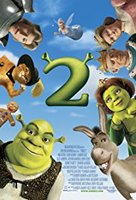
The second film in the Shrek franchise, Shrek 2 focuses on a pair of ogres, Shrek and Fiona, and their life as newlyweds: it’s time to meet the in-laws. Fiona’s human parents, King Harold and Queen Lilian, are unpleasantly surprised by the fact their daughter and her husband are ogres, and their marriage has a few magical opponents too, in the form of the Fairy Godmother and her son Prince Charming, who wants (human) Fiona for himself. Shrek and Donkey, his loyal talking animal sidekick, go on an adventure to win over Fiona’s parents, befriending another talking animal Puss in Boots along the way, who was initially hired by Harold to kill Shrek. In desperation, Shrek looks for magical assistance, and alongside Fiona is transformed into a human, while Donkey becomes a white stallion. Shrek has to kiss Fiona before midnight in order to remain human, but the Fairy Godmother attempts to thwart them. Harold redeems himself by leaping in front of Shrek to protect him, getting turned into a frog in the process. The film ends as Shrek and Fiona decide to turn back into ogres, remaining their true selves.
As an animated family comedy, the film depicts animals in all sorts of magical and anthropomorphised ways. Shrek 2 draws on and parodies familiar fairy-tale and Hollywood tropes in order to create humour, putting a fresh twist on traditional narrative conclusions of wealth and beauty. The comedic fairy tale setting allows for the inclusion of magical creatures such as ogres, fairies, famous names like Pinocchio or the Gingerbread Man, and talking animals. There are some inconsistencies with the animals in the magical world, for example only certain animals can actually speak, mainly Donkey, Puss in Boots, and the King when he is a frog. Shrek and Donkey are both lovable outsiders, trying to assimilate into a world that often rejects them, while the King is insecure about his own animality, desperate to distance himself from those who remind him of the potential fluidity of human/animal identity because of his past life as a frog. The animal representation this article will examine is primarily that of transformation, looking at Donkey’s transformation into a white stallion, and discussing King Harold’s transformation into a frog, alongside the plot twist where it emerges he lived as a frog before he became King, in allusion to the Grimm’s fairy tale ‘The Frog Prince’.[1]
This film, as many texts that heavily feature animal/human relations, plays on the oppositional tensions within ‘the construction of the natural world as wild and the recognition of culture as a model of apparently civilised social order’.[2] The scene that first establishes these tensions between animals and humans is the family dinner, where Shrek, Fiona, Donkey, Harold, and Lilian sit at a grand table, Shrek at one end, King Harold at the other. Behind Shrek is a fire and a huge stuffed eagle, claws out, directly above his head. The mise-en-scène here is designed to make Shrek appear trapped, in contrast to the open doors behind the King. The stuffed eagle also serves to remind the viewer of Shrek’s animality, and consequent outsider status. Donkey bursts in halfway through the scene—‘what’s happening everybody?’—but before this we can hear off screen the sound of him forcing his way through the kitchen—‘don’t tell me you don’t know who I am’.[3] He takes a seat next to the Queen, placing his hooves on the table in a humanlike way, but the King attempts to make him get down—‘no! No, bad donkey, bad. Down’.[4] It is evident that even though Donkey has proved he can speak, the King still views him as a dumb beast, attempting to control him through typical language you would use to train a dog, instead of treating him like a strange human at the table, and attempting to communicate properly.[5] Fiona defends him—‘it’s okay! He’s with us’—but Donkey’s animal presence and alignment with Shrek and Fiona distances them further from the human King and Queen.[6] The King’s incapacity to communicate with Donkey mirrors his unwillingness to accept Shrek. He undermines their attempts to appear more civilised as well, for example when Fiona mentions Shrek owns land, Donkey interrupts ‘what? I know you ain’t talking about the swamp!’ Donkey functions as a reminder of Shrek’s animality and outsider status by his direct contrast with the civilisation of the scene, suggesting animality as an allegory for being lower class.
Taking this further, I think the species tension and the othering of Shrek and Donkey represents not only class but racial tensions. The ultimate ‘otherness’ of animals means they are often used in mainstream cinema to discuss issues of social exclusion, which can otherwise be either too taboo or inaccessible for children (or both).[7] Donkey in particular, voiced by Eddie Murphy, speaks in African-American Vernacular English, in direct contrast to the upper-class English accents of the King and Queen (and the villains, Fairy Godmother and Prince Charming).[8] Fiona and Shrek also contrast against this Englishness, but not quite to the same extent, as Fiona is inexplicably American, while Shrek is Scottish. The use of AAVE aligns Donkey with blackness, and his experience being ostracised at the dinner table, in addition to his lack of invitation, can be read as an allegory for racial discrimination. Despite Fiona vouching for him, explaining that he saved her from the dragon with Shrek, and his own claims to being a ‘noble steed’, the King and Queen disregard him.[9] Furthermore, when Puss in Boots is sent by the King to attack Shrek and he fails, it is unclear as to why he befriends them instead of just leaving. As an outsider, both through being Spanish (voiced by Antonio Banderas) and as a talking animal, it’s possible he finally finds a sense of belonging with Donkey and Shrek.
The concept of ‘noble steed’ needs to be examined further too, as later in the film Donkey undergoes a transformation alongside Shrek.[10] Donkey and Shrek both drink a magic potion in order to live ‘Happily Ever After’, and in the morning, Shrek is a human and Donkey has become a (white) stallion.[11] The reveal here is dramatic and humorous, as Shrek asks ‘have you ladies seen my donkey?’ and Donkey calls from off-screen ‘who are you calling Donkey?’[12] The camera quickly pans to Donkey as a white stallion posing with one hoof up, backlit and outlined by the doorway, in a way reminiscent of Renaissance paintings of Kings on horseback, as a non-diegetic fanfare plays, aligning Donkey with nobility.
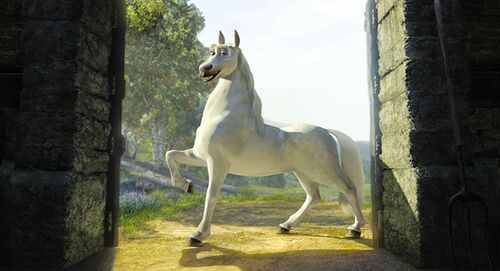
He is now a ‘stallion, baby!’, and as an uncastrated male horse connotes ideas of virility, power, testosterone and masculinity, and potentially greater humanity: ‘stallion’ is commonly used to imply sexual prowess for humans as well.[13] His identity now is performative, and exists under human interpretation and training of horses: ‘I can whinny! [whinnies] I can count! [paws ground] Look at me Shrek: I’m trotting [trots in a circle]’.[14]
He seems to have achieved greater civilisation through his transformation, both as a more highly trained and human animal, and through his whiteness. Why animate a white horse? His ‘Happy Ever After’ here is not only a species change but a bleaching that is connected to greater physical attractiveness.[15] Donkey is pleased with his new horse body, which is problematic if read as him no longer being an outsider: he’s happier that now he externally appears more civilised, and is white.
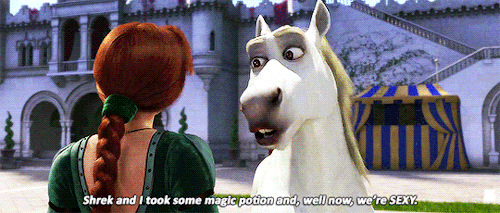
In a subversion of traditional fairy tale tropes where happy endings are only for the beautiful, Shrek, Fiona and Donkey all revert to their previous selves. Fiona stops Shrek from kissing her before midnight to prevent the transformation into human from becoming permanent: ‘I want … to live happily ever after with the ogre I married’.[16] The moral message of the narrative for its family audience seems to be that being true to yourself is more important than trying to be someone else. However, Donkey is unhappy about no longer being a stallion, because it means losing his image of higher-class status, and potentially his whiteness. As he transforms back into a donkey, his horseshoes fly off his hooves and hit him in the face, a symbol of the loss of civilisation. It is curious that Donkey longs to keep the symbol of his relative humanity, while Shrek and Fiona are happy to transform. Perhaps this is because as ogres, they have a distinct species categorisation and are relatively humanoid, while Donkey’s hybridity means he gets classified as an animal, but still doesn’t quite belong anywhere (after all, his girlfriend is a dragon).
The dramatic finale also exposes the King’s previous animality. Throughout the film there are allusions to his past life as a frog, for example when he is in a dimly lit bar, a female frog with red lips purrs ‘do I know you?’, while the Fairy Godmother regularly fires threats his way: ‘we made a deal, Harold. And I assume you don’t want me to go back on my part’.[17] Presumably this deal involved the Godmother using her magical powers to transform the King from a frog into a human, which she then uses to blackmail him. The allusions to his past animality inform the similarities in the way that the King and Shrek are presented on screen, for example the mirroring during the dinner scene of them punctuating their argument by destroying food on either end of the table.
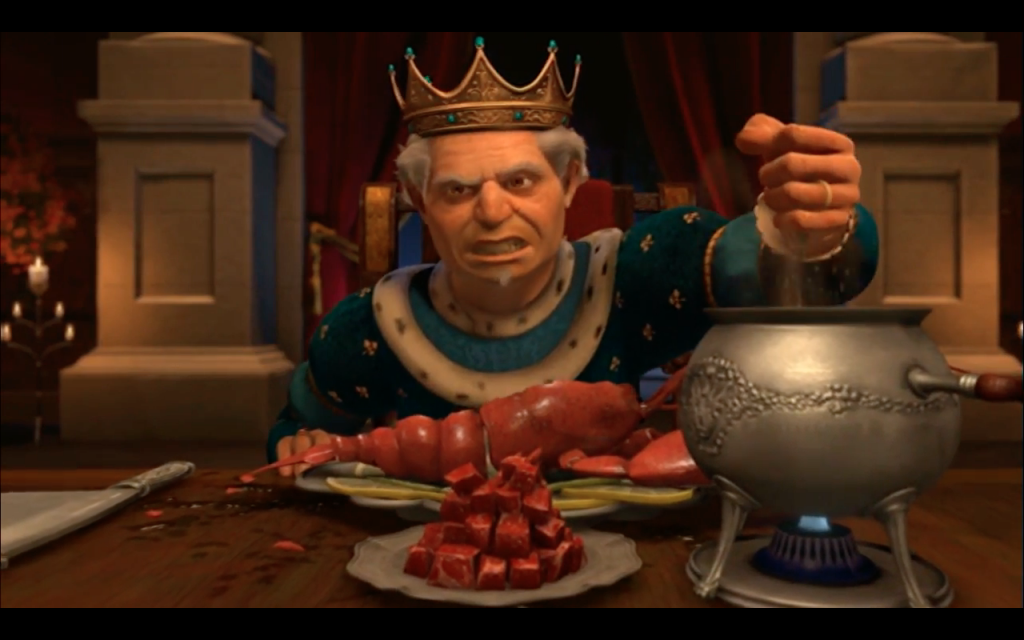
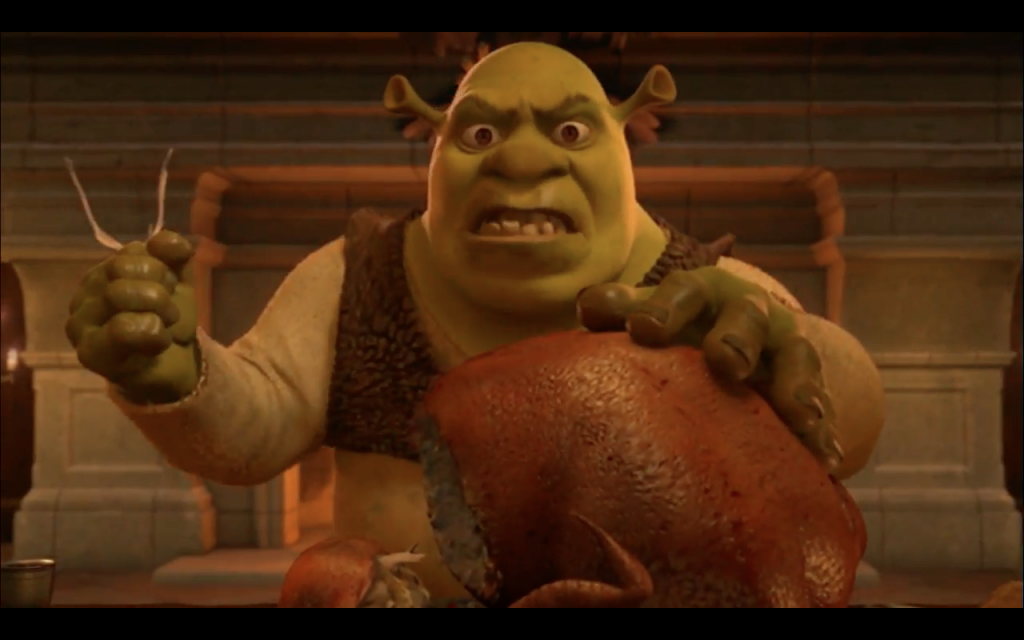
Harold loathes Shrek so much because animalistic qualities (highlighted by association with Donkey) reminds him of what he was. The audience is unaware of this, and does not find out the full history of Harold as a frog until the end, when he leaps in front of Shrek to protect him and is turned back into a frog by the Fairy Godmother. There is a brief moment where he is potentially dead, and the camera looks up at Shrek, Fiona and the Queen’s horrified faces over Harold’s empty armour, but the tension is broken by the sound of a croak, and a pun as Ginger says mournfully ‘yep—he croaked’.[18] Frog Harold crawls out of the armour, redeemed for his actions during the film and humbled by his position—the camera angle looks down on him, from Shrek and Fiona’s perspective, as he apologises. Harold is punished and consequently redeemed by becoming an animal, being forgiven by Lilian after he attempts to leave: ‘I just wish I could be the man you deserved’ … ‘you’re more that man today than you ever were’.[19] His acceptance of otherness, both in himself and Shrek, brings him peace.
The animals in this film represent otherness, being an outsider, and a lack of supposed civilisation, functioning as an allegory for social exclusion due to class or race. Species transformation allows the characters to alter their social status purely through physical change, suggesting the superficiality of social exclusion. The humans who attempt to keep strict boundaries in place are upper class and discriminatory: either the villains of the film (Fairy Godmother and Charming) or foolish and weak (King Harold). Ultimately, for the ogres, otherness is celebrated and returned to. However, the hybrid Donkey’s lack of desire to return to being a Donkey implies a difference among animal identity: instead of being human or not-human he is only Donkey or not-Donkey, which is considered less of an identity crisis or major shift, because it all falls under the umbrella term of animal. Species crises are considered more appropriate for humanoids, rather than those who identify as animals, and Donkey is relegated to position of sidekick. He is insecure about being a donkey, and has to be validated by being called a ‘noble steed’ by Shrek, who has achieved more civilisation than him. Donkey serves a dual purpose, as both aligning Shrek and Fiona with animality, but also through creating a hierarchy where they are above him.
In conclusion, animals in this film represent Shrek’s animality, but also emphasise his capacity for humanity, as he is the leader. Puss in Boots and Donkey both orientate towards him, and support his quest for human assimilation. Ultimately, he proves himself to be as noble and courageous as any human could be. The animals effectively serve to inform the experiences of the humans or humanoid creatures on screen. The film has parallels with other family films, for example Beauty and the Beast, but chooses to subvert the fairy tale expectation of becoming human and beautiful in the finale, a slightly different moral message for the children watching: good looks do not necessarily represent a good person.
[1] Brothers Grimm, ‘The Frog Prince’ in Grimms’ Fairy Tales, published at Project Guterberg http://www.gutenberg.org/files/2591/2591-h/2591-h.htm#link2H_4_0064 [accessed 20 May 2018].
[2] Paul Wells, The Animated Bestiary (Rutgers University Press: New Jersey, 2009) p. 19.
[3] Andrew Adamson, Kelly Asbury, and Conrad Vernon, Shrek 2 (DreamWorks, 2004).
[4] Ibid.
[5] Ibid.
[6] Ibid.
[7] Paul Wells, p. 30.
[8] John R. Rickford, African American Vernacular English: Features, Evolution, Educational Implications, (Wiley: New Jersey, 1999).
[9] Shrek 2 (2004).
[10] Ibid.
[11] Ibid.
[12] Ibid.
[13] Ibid.
[14] Ibid.
[15] Ibid.
[16] Ibid.
[17] Ibid.
[18] Ibid.
[19] Ibid.